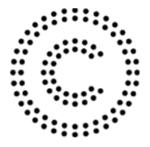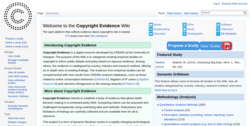Copyright Evidence
Copyright Evidence is an English language wiki encyclopedia of empirical studies on copyright. It categorises legal studies on copyright so as to inform the public and policy development based on evidence. It was setup and run by CREATe at the University of Glasgow.[1]
 | |
Screenshot  | |
Type of site |
|
|---|---|
| Available in | English |
| Owner | University of Glasgow |
| URL | www |
| Commercial | No |
| Registration | Optional (required to edit pages) |
| Launched | 2014 |
| Current status | Active |
History
Copyright Evidence was established in 2014 by Theo Koutmeridis, Kris Erickson, and Martin Kretschmer, as a project undertaken by the CREATe research centre[2]. The project aims to be a consolidated and interdisciplinary “central source” for evidence-based copyright studies[3], where users can examine findings and methodology transparently.
An editorial board was established in December 2017, which included the appointment of a sub-editor responsible for growing the existing base of studies[4].
Methodology
Initial studies eligible for Copyright Evidence were identified using a snowball sampling methodology, beginning with a literature review by Watson, Zizzo and Fleming[5]. Thereafter: 103 working papers and pre-prints were identified through the SSRN e-journal Intellectual Property: Empirical Studies (published between November 1996 and July 2015)[6]; 81 studies via literature reviews by Handke[7], Kretschmer[8], and Kheria[9]; and 50 governmental reports as proposed by CREATe doctoral candidates.
Ongoing growth of Copyright Evidence is achieved by search-based identifications. A literature review, conducted by the University of Illinois[10], confirmed the veracity and comprehensiveness of Copyright Evidence in late-2018.
Format
Copyright Evidence catalogues all “empirical studies on copyright in an attempt to inform policy interventions based on rigorous evidence”[11]. Permitted studies may also include multi-disciplinary elements, and do not need to be strictly legal in nature. Copyright Evidence is currently closed for unauthenticated user submissions, with relevant studies being identified and coded by a community of CREATe research assistants.
Each entry details the main findings of the relevant study, a description of the data involved, and relevant policy considerations. Studies are also categorised (amongst other factors) by country, JEL code, and research method. Iconographic indicators are used to identify the relevant industry, fundamental issues, and policy areas.
Findings
Copyright Evidence currently holds details of over 600 evidence-based studies on copyright, and acts as a dynamic literature review platform which is open to text and data mining.
Mining and visualisation tools were explored during the 2016 EUHackathon[12][13][14], which identified certain clusters of cross-referencing between key related studies. Governmental reports, for example, tend to cross-reference other governmental reports, but less so academic evidence on copyright[15].
Copyright Evidence visualisations provide summary statistics on the landscape of the indexed studies[16]. These demonstrate how the majority of copyright studies focus on: (a) the sound recording and music publishing industry; (b) understanding consumption/use (e.g. determinants of unlawful behaviour, user-generated content, social media), and; (c) enforcement (quantifying infringement, criminal sanctions, intermediary liability, graduated response, litigation & court data, commercial VS non-commercial, education & awareness)[17][18].
Copyright Evidence is cited as a resource to support the use of empirical evidence in informing copyright policy[19][20][21][22].
References
- "Copyright Evidence". www.copyrightevidence.org. Retrieved 2018-09-29.
- "Copyright Evidence". www.copyrightevidence.org. Retrieved 2018-10-22.
- "Research Blog Series: The Copyright Evidence Wiki". CREATe. 2018-03-09. Retrieved 2018-10-22.
- "Copyright Evidence". www.copyrightevidence.org. Retrieved 2018-10-22.
- "Determinants and Welfare Implications of Unlawful File Sharing: A Scoping Review". CREATe. 2014-04-09. Retrieved 2018-10-22.
- "Intellectual Property: Empirical Studies eJournal :: SSRN". papers.ssrn.com. Retrieved 2018-10-22.
- Handke, C (22 October 2018). "Economic Effects of Copyright: The Empirical Evidence So Far. The Committee on the Impact of Copyright Policy on Innovation in the Digital Era" (PDF).
- Kretschmer, Martin (2012). "Does Copyright Law Matter? An Empirical Analysis of Creators' Earnings". SSRN Working Paper Series. doi:10.2139/ssrn.2063735. ISSN 1556-5068.
- Kheria, S (2013). "Copyright and Digital Art Practice: The 'Schizophrenic'Position of the Digital Artist". Leonardo Electronic Almanac. 19 (4).
- "Research Blog Series: The Copyright Evidence Wiki". CREATe. 2018-03-09. Retrieved 2018-10-22.
- CREATe (2016). "A Guide to using the Copyright Evidence Wiki" (PDF).
- "EUHackathon 2016: visualising copyright evidence | Kennisland". Kennisland. Retrieved 2018-10-22.
- "EU Hackathon: Visualizing Copyright Evidence". UK Copyright Literacy. 2016-08-24. Retrieved 2018-10-22.
- "Europe Code Week". codeweek.eu. Retrieved 2018-10-22.
- "Research Blog Series: The Copyright Evidence Wiki". CREATe. 2018-03-09. Retrieved 2018-10-22.
- "Example Visualisations - Copyright Evidence". www.copyrightevidence.org. Retrieved 2018-10-22.
- Erickson, K., Koutmeridis, T., Kretschmer, M., and McHugh, A. (2015). "CopyrightEvidence.org" (PDF).CS1 maint: multiple names: authors list (link)
- EPIP 2015 (2015-09-22), EPIP 10th Annual Conference: CREATe Copyright Evidence WiKi, retrieved 2018-10-22
- Frosio, G (2018). Reconciling Copyright with Cumulative Creativity: The Third Paradigm. Cheltenham: Edward Elgar Publishing Limited.
- "The economic effects of copyright - CORE". CORE. 2017-03-20. Retrieved 2018-10-22.
- CopyrightAgency (2015) Submission to Productivity Commission Intellectual Property Arrangements Issues Paper (November 2015) at p13
- European Commission (2012) Evaluation of the application of Regulation 386/2012 Final Report at p36